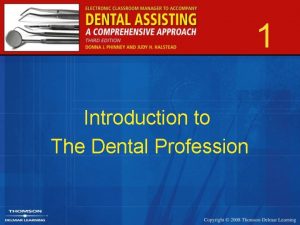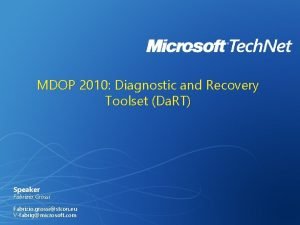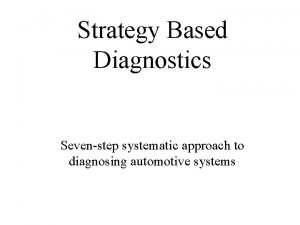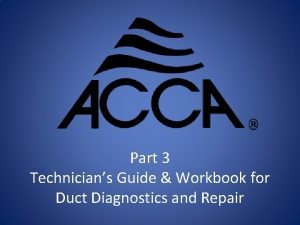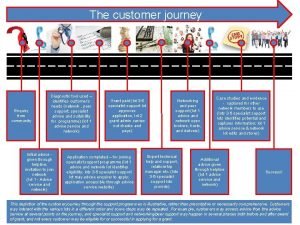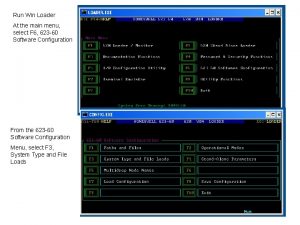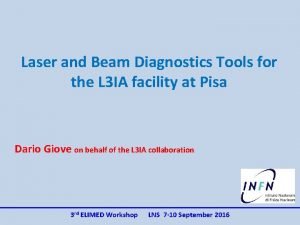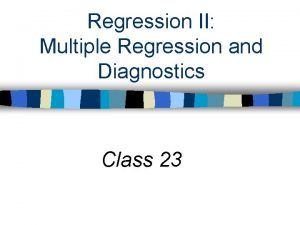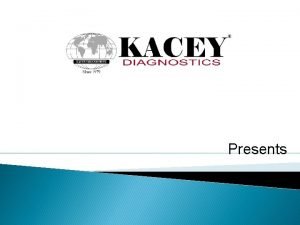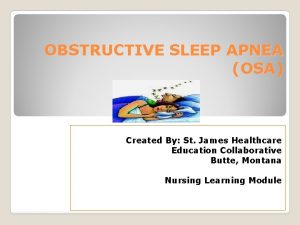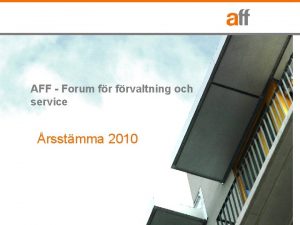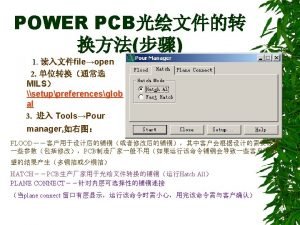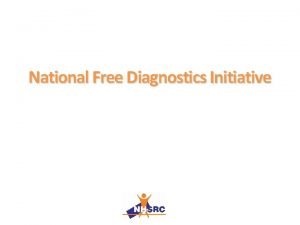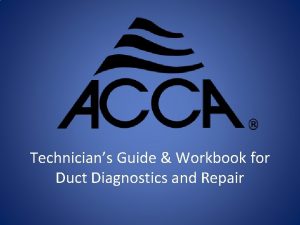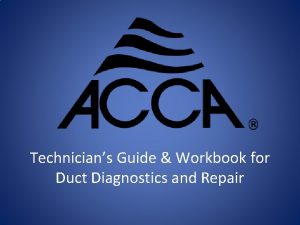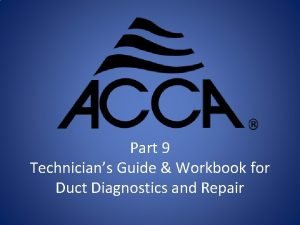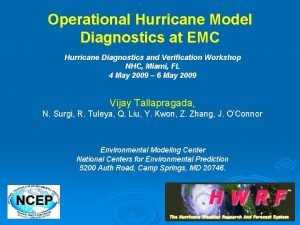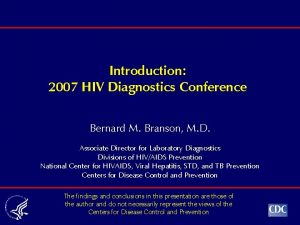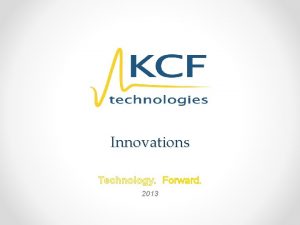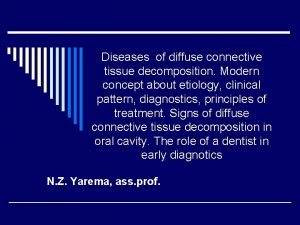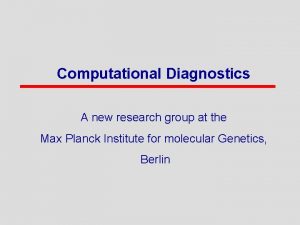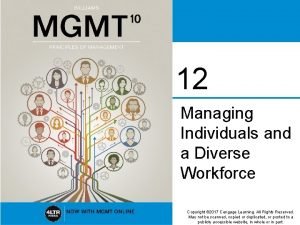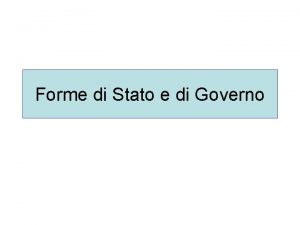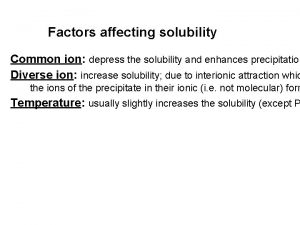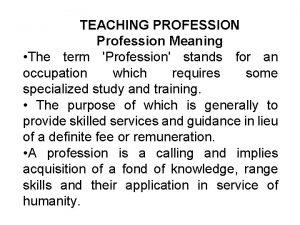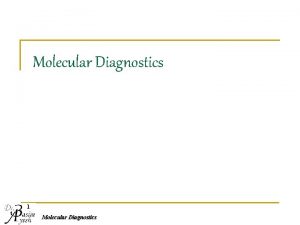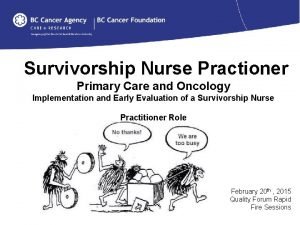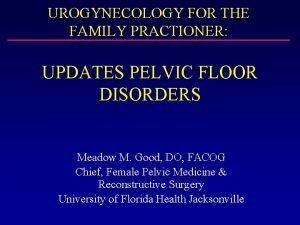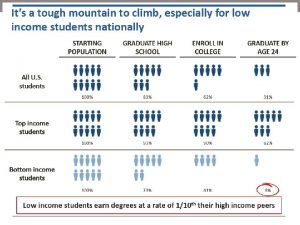Introduction to diagnostics Wonderful and diverse profession Practioner















































- Slides: 47

Introduction to diagnostics

• Wonderful and diverse profession • Practioner to possess a wide range of skills, knowledge and personal characteristics

SLP work as Case selector Case evaluator Diagnosticia n interviewer Parent counsellor Teacher Consultant Coordinator Record keeper Researcher

STUDENT CLINICIAN MOVE FROM ONE AREA TO ANOTHER MAXIMIZE STRENGTH IN ALL ASPECTS AND TO PROVIDE BEST POSSIBLE SERVICES

DIAGNOSIS • Comprehensive and difficult task • Requires synthesis of entire field Knowledge of norms and testing techniques Skills in observation Ability to relate effectively and empathetically Great deal of creative intuition

• Communication is a function of entire person, thus it is important to scrutinize all aspects of behaviours. • Need to know about changing people in a dynamic environment. • Need to diagnose communicators not just communications.

Diagnosis process = science and art Science Art • Each case – clinician to think , solve problem, form hypothesis, gather data and arrive at conclusion • Assessment is much more than the simple administration of a few psychometrically adequate test or scales.

• Diagnostician must have neutral conduct – interact with client to determine the real effect of communication impairment. • Functional consequence

Diagnosis • Greek word “to distinguish”. • Dia – apart • Gnosis- to know • Distinguishing a persons problem from a large field of potential disabilities.

Evaluation • Process of arriving at a diagnosis • Initial diagnosis • Competent clinician should continue the evaluation

Assessment • • • Ongoing process Gathering baseline data, monitoring treatment progress, determining if generalization has occurred from training and documenting functional gains in communication

FOUNDATIONAL INTEGRITY -5 PRINCILES • • • THOROUGH VARIETY OF ASSESMENT MODALITY VALID RELIABLE TAILORED TO INDIVUDAL CLIENT

SEVEN STEPS IN COMPLETEING AN ASSESSMENT • • • OBATIN HISTORICAL INFORMATION INTERVIEW THE CLIENT STRUCTURAL AND FUNCTIONAL INTEGRITY OF OPME SAMPLE AND EVALAUTE SCREEN THE CLIENTS HEARING EVLAUTE ASSMT INFORMATION TO DETERMINE IMPRESSION, DIAGNOSIS/ CONCLUSION • SHARE CLINICAL FINDING THROUGH AN INTERVIEW.

Diagnostic and Statistical Manual of Mental Disorders (DSM) • Provides the standard language by which clinicians, researchers, and public health officials communicate about mental disorders. • The current edition of the DSM, the fifth revision (DSM-5) , was published in May 2013

1952: DSM-I 1968: DSM-II 1980: DSM-III 1987: DSM-III-R 1994: DSM-IV 2000: DSM-IV-TR 2013: DSM-5

DEVELOPMENT • DSM-5 was constructed with the goal of addressing limitations in the DSM-IV while integrating the latest scientific and clinical evidence on the empirical basis of psychiatric disorders. • The priority was to ensure the best care of patients possible and, in the process, improve usability for clinicians and researchers.

Classification • The DSM-5 is based on explicit disorder criteria, which taken together constitute a “nomenclature” of mental disorders, along with an extensive explanatory text that is fully referenced for the first time in the electronic version of this DSM.

SECTIONS A. Neurodevelopmental Disorders B. Schizophrenia Spectrum and Other Psychotic Disorders C. Bipolar and Related Disorders D. Depressive Disorders E. Anxiety Disorders F. Obsessive-Compulsive and Related Disorders G. Trauma- and Stressor-Related Disorders H. Dissociative Disorders J. Somatic Symptom and Related Disorders K. Feeding and Eating Disorders L. Elimination Disorders

M. Sleep-Wake Disorders N. Sexual Dysfunctions P. Gender Dysphoria Q. Disruptive, Impulse-Control and Conduct Disorders R. Substance-Related and Addictive Disorders S. Neurocognitive Disorders U. Personality Disorders V. Paraphilic Disorders W. Other Mental Disorders X. Medication-Induced Disorders Y. V and Z codes


Purposes of ICD • • Monitor health epidemics/threats to public Assess health/disease burden Identify vulnerable/at risk populations Define obligations of WHO members to provide health care access to their populations • Form guidelines for care & standards of practice • Facilitate research into more effective treatments

History of ICD, continued • ICD-1 first revision 1900 (in use 1900 -1909). No Mental and Behavioral Disorders • ICD-2 1909 (1910 -1920), International Classification of Causes of Sickness & Death • ICD-3 1920 (1921 -1929) • ICD-4 1929 (1930 -1938), transfer to categories based on etiology • ICD-5 1938 (1939 -1948), practical consideration devoted to comparability between successive ICD versions (GEMs) • And then WWI and the founding of the UN

History of ICD, continued • WHO constitution ratified 1948 and entrusted with the ICD • ICD-6 1948 (1949 -1957 ) 1 st WHA adopted the renamed International Classification of Diseases, Injuries, and Causes of Death. • Morbidity added to mortality • Introduced Mental, Psychoneurotic, and Personality Disorders.

ICD Sample Chapters and Codes Chapter Range of Codes I. Certain infectious and parasitic diseases II. Neoplasms III. Disease of the blood IV. Endocrine, nutritional and metabolic diseases A 00 -B 99 C 00 -D 48 D 50 -D 89 E 00 -E 90 V. Mental and behavioral disorders F 00 -F 99 VI. Diseases of the nervous system VII. Diseases of the eye and adnexa VIII. Diseases of the ear and mastoid process IX. Diseases of the circulatory system X. Diseases of the respiratory system …continues through XXI. Factors influencing health G 00 -G 99 H 00 -H 59 H 60 -H 95 I 00 -I 99 J 00 -J 99 status and contact with health services (Z 00 -Z 98)

Common type of test • Standardized – same manner across all indvl • Non standardized – different manner

Standarized test • Norm referenced • Criterion referenced

Norm referenced test • Standarized • Comparisonof individual performance to the performance of larger group • Test developers to determine normative standard that will identify what avg is for a given test


Advantage • • Objective Efficient Skills can be compared Common ground of discussion Clinician donot require high clinical expertise to administer

Disadvantage • • • Do not allow indvl variation Static – tells wahta a person knows not how a person learn Testing envmt- unnatural Evaluate- isolated skills withut considering other factors Should be administered as instructed May not be appropriate for certain population.

Criterion referenced test • Identify what a client can and cannot do compared to a predefined criterion • Assumes a level of performance that must be met for a behavior to be acceptable. • Any score below- deviant • May /maynot be std

Advantage • Objective • Efficient

Disadvantage • Test envmt- unnatural • Isolated skills

Foundation of test or measure • Validity • Reliability

Validity • Refers to the degree to which a procedure actually measures what it purports to measure. • Related to the purpose for which the test is used

Face validity • Test looks like it asseses the skill it claims to assess.

Content validity • Test contents are representative of the content domain of the skill being assessed. • Judgemental in nature and requires clear definition of what the content should be. •

Established by three factors • Appropriateness of the type of items. • The completeness of the item sample. • The way in which the item assess the content.

Construct validity • Test measures a theoretical construct or trait • Rely on indirect evidence and reference. •

Criterion validity • Established by use of an external criteria.

Reliability • Results are replicable • When administered properly, a test gives consistent results on repeated administration • With different interpreters judging the same admin.

Test – retest reliability • Test stability over time • Administer same test multiple times to same group then comparing score • Similar – reliable and stable.

Rater reliability Intra rater Inter rater Same person more than one time More than person- result consistent

Split half reliability • Test internal consistency • Results from one half correlated with results in another half

Dynamic assessment • Notion of using time in diagnostic session to gain insight into the performance on treatment task • Learning process and direction for treatment • Rely on the Vygotsky ZPD.

Static assessment • Snap shot of child performance. • Standardised test

Static Dynamic • • • Active participants • Examiner participates • Results describe modifiability • Administration fluid and responsive. Passive participants Examiner observes Result identify deficits Standardized administration
 It a wonderful world no need to run and hide
It a wonderful world no need to run and hide How does it move
How does it move God's love is so wonderful
God's love is so wonderful Wonderful wonderful jesus
Wonderful wonderful jesus What is a chapter 1 teacher
What is a chapter 1 teacher Robert woofendale
Robert woofendale Da toolset
Da toolset Mitel presenter
Mitel presenter Gm strategy based diagnostics chart
Gm strategy based diagnostics chart Duct diagnostics
Duct diagnostics Customer journey diagnostics
Customer journey diagnostics Loader diagnostics main menu
Loader diagnostics main menu Standard diagnostics inc
Standard diagnostics inc Laser beam diagnostic
Laser beam diagnostic Cristina brunet
Cristina brunet Q
Q Cole diagnostics jobs
Cole diagnostics jobs Casewise diagnostics
Casewise diagnostics Kacey diagnostics
Kacey diagnostics Ramsay scale
Ramsay scale Strongstep diagnostics
Strongstep diagnostics Aff definitioner
Aff definitioner Maximum number of diagnostics exceeded
Maximum number of diagnostics exceeded Molecular diagnostics
Molecular diagnostics Realtime diagnostics
Realtime diagnostics Free diagnostics service initiative
Free diagnostics service initiative Cpvc ductwork
Cpvc ductwork Duct diagnostics
Duct diagnostics Duct diagnostics
Duct diagnostics Emc diagnostics
Emc diagnostics Hiv diagnostics conference
Hiv diagnostics conference Kcf smart diagnostics
Kcf smart diagnostics Connective tissue
Connective tissue Computational diagnostics
Computational diagnostics Dbghost.exe
Dbghost.exe Felice shieh
Felice shieh Diverse comparative and superlative forms
Diverse comparative and superlative forms Working with culturally and linguistically diverse families
Working with culturally and linguistically diverse families Family matters definition
Family matters definition What is deep level diversity
What is deep level diversity Wonderful plan
Wonderful plan Turtles are wonderful creatures subject and predicate
Turtles are wonderful creatures subject and predicate Most diverse group of organisms
Most diverse group of organisms Refractia
Refractia Sporozoa
Sporozoa It diverse information sharing through universal web access
It diverse information sharing through universal web access Forme di stato e di governo schema
Forme di stato e di governo schema Diverse ion effect
Diverse ion effect





